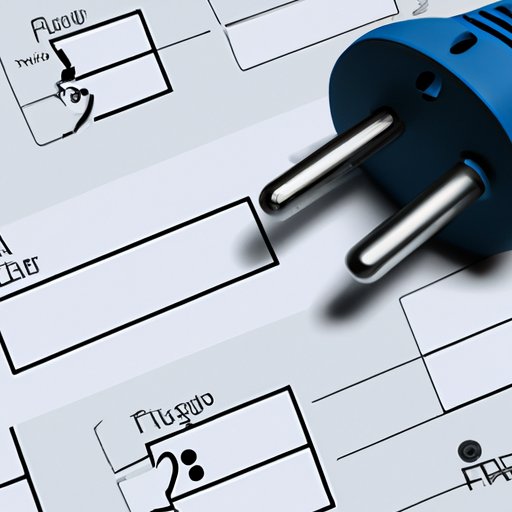
I. Introduction
Watt is a measure of power, and it’s significant in determining the amount of electricity we consume daily. It’s essential to understand how to calculate watt to manage energy flow and, ultimately, lower your electricity bill. In this article, we’ll cover the basics of watt, how to calculate watt for your home appliances, the importance of understanding watt, maximizing energy efficiency, and ways to save money on energy bills.
II. The Basics of Watt
Watt is the standard unit of power, and it measures the rate of energy used per second. The higher the wattage, the more power the device uses. The kilowatt-hour (kWh) is the standard unit for measuring energy usage over time. An appliance that uses one watt of power for one hour consumes one watt-hour (Wh) of energy. Understanding the difference between watt and kWh is essential when calculating energy usage.
Knowing the wattage of each appliance can help you manage your energy consumption. There is a direct correlation between watt and energy bills, as the higher the wattage an appliance consumes, the more energy it uses, and the higher your electricity bill will be.
III. Step-by-Step Guide: How to Calculate Watt for Your Home Appliances
To calculate watt for your home appliances, you need to understand the basics of voltage and amperage. Voltage is the measure of electrical pressure, while amperage is the measure of electrical current that flows through the circuit. Watt is calculated by multiplying the voltage by the amperage.
Appliances come with labels that indicate their voltage, amperage, and power (watts). You can use these labels to calculate power consumption. The formula for calculating watt is P (power) = V (voltage) x I (amperage).
Here’s how to calculate watt for a specific appliance:
- Find the voltage (V) for the device. You can find this information on the label, in the manual or online.
- Find the amperage (I) for the device. This information is also on the label or in the manual.
- Multiply the voltage and amperage to get the wattage (P) of the device.
For example, if you look at the label of a vacuum cleaner and see it has a voltage of 120V and an amperage of 10A, the wattage will be P = 120V x 10A = 1200 watts. This means that the vacuum cleaner uses 1200 watts of power per hour of use.
IV. The Importance of Understanding Watt: How to Calculate Power Consumption
Understanding watt is crucial in managing energy consumption at home. High wattage appliances, such as air conditioners, heaters, and dryers, consume more energy than low wattage appliances such as lighting, televisions, and computers.
When it comes to calculating power consumption, the higher the wattage, the more energy it consumes, and the higher your electricity bill will be. By understanding the wattage of each appliance, you can become more aware of your power consumption and make adjustments accordingly.
It’s also essential to determine the electrical requirements of your house. Homes that are wired for high electricity consumption can handle more high wattage appliances than those that aren’t. Understanding your home’s electrical requirements will help you choose the right appliances and avoid overloading your electrical system.
V. Maximizing Your Energy Efficiency: Tips for Calculating Watt
Maximizing energy efficiency at home involves selecting appliances that consume minimal power and limiting the use of high wattage appliances. When selecting appliances, you should consider the wattage and energy star rating. Energy star appliances meet the highest standards of energy efficiency and are the most efficient appliances on the market.
You can use the wattage calculation to determine which appliances to purchase. Selecting appliances with lower wattage can help you save money on your energy bills. It’s also important to use appliances strategically by scheduling their use to minimize consumption. For example, using a dishwasher or washing machine during off-peak hours can save energy.
Another way to reduce energy consumption is by shifting habits. simple habits like turning off lights and unplugging appliances when they are not in use can reduce energy consumption significantly. Smart power strips are another tool you can use to reduce energy usage. They automatically turn off appliances when not in use, cutting power consumption.
VI. From Formulas to Results: A Guide to Calculating Watt
Calculating watt is a straightforward process that involves formulas, labels, and results. By using this article’s tips and examples, you can learn how to calculate watt for your appliances and understand your power consumption. Making energy calculations is the best way to conserve energy, reduce your carbon footprint, and save money on your energy bills.
The Watt calculator is the best tool for calculating consumption and managing energy consumption. You can use it to calculate your energy usage and determine how energy-efficient your appliances are. It’s a valuable tool in creating an energy-efficient household.
VII. How to Save Money on Your Energy Bills: Simple Methods for Calculating Watt
Lowering your energy bills can be achieved by being more mindful of your wattage usage. By calculating power consumption, selecting energy-efficient appliances, shifting habits, using appliances strategically, and understanding your home’s electrical requirements, you can reduce energy consumption and lower your energy bills significantly.
Understanding watt consumption is critical in reducing energy costs. Therefore, it’s essential to apply the principles explained in this article to save money on your energy bills regularly. By being mindful of your power consumption, you reduce your carbon footprint and promote a more sustainable environment.
Conclusion and Call to Action
Calculating watt can help you manage your energy consumption, save money on your electricity bills, and reduce your carbon footprint. Understanding watt consumption, electrical requirements, and the labels on your appliances can help you become more energy-efficient. By selecting appliances with a low wattage, shifting your habits, using appliances strategically, and calculating power consumption regularly, you can save hundreds of dollars on your energy bills yearly. Be mindful of your wattage usage, save money, and contribute to a more sustainable environment today.




